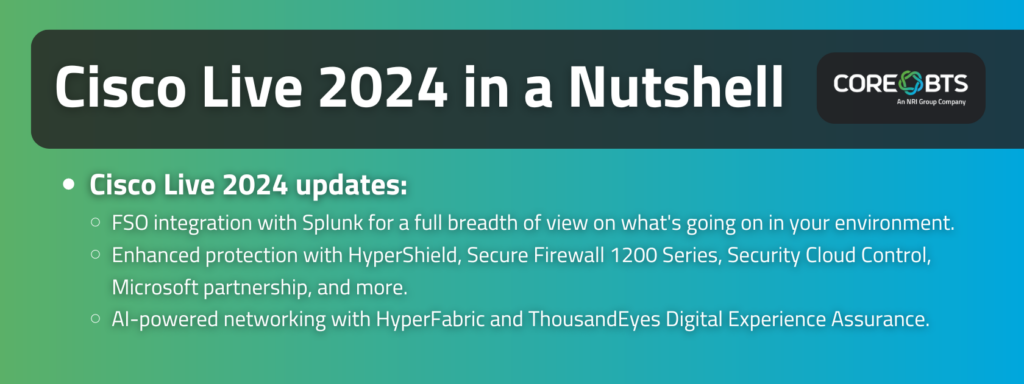During its annual flagship event, Cisco unveiled Splunk integrations and several security and networking innovations powered by AI. Here are the highlights:

This year’s Cisco Live in Las Vegas edition was abuzz with activity and exciting updates. Roughly 20,000 IT and security experts, including Core BTS pros, came together to network and learn about Cisco’s vision for the future.
Among the key agendas were the tech giant’s plans for artificial intelligence (AI) and its $28 billion Splunk acquisition. And just like in Cisco Live 2023, the tech giant was keen to emphasize its commitment to innovation and integration. To that end, Cisco announced a range of new capabilities and products designed to offer better connection, insights, and protection. These correspond to its chief domains: observability, security, and networking.
This blog recaps the key takeaways from Cisco Live 2024 and what it means for your business going forward.
Full-Stack Observability With Splunk
As expected, the Splunk acquisition was featured prominently in the keynotes. Splunk offers industry-defining monitoring and observability solutions and ranks among the top 20 players in the field.
Cisco plans to bolt log analytics and incident response onto existing observability offerings. This move will help you unlock new levels of monitoring and troubleshooting across your entire enterprise. AppDynamics and Splunk will now be available on Microsoft Azure, allowing you to maximize the platform’s data features and capabilities.
The new, full-stack observability (FSO) portfolio ties in Splunk observability cloud, IT service intelligence (ITSI), and AppDynamics. A single sign-on will eliminate logging friction and allow shared workflows across these platforms.
Splunk will act as a data lake anchor point, helping you harness information from other systems outside the Cisco ecosystem. For example, you can dump event logs from operating systems, applications, microservices, and Active Directory environments into Splunk and then feed the information into the extended detection and response (XDR) platform. This will significantly expand the scope of what you can see and prioritize as far as threats are concerned.
In other words, you’ll now have a true powerhouse of observability, application troubleshooting, granularity, and ingestion of logs from networking everywhere.
Security Improvements
Security was also a key theme in the event. Cisco provided updates about its collaboration with Microsoft, the upcoming HyperShield architecture, and the Secure Firewall 1200 series set to replace the 1100 family. The vendor also announced plans to tie everything together with Security Cloud Control.
HyperShield Architecture: This is a distributed exploit protection and micro-segmentation solution for public and private workloads.
The gap between when a threat is announced and weaponized has considerably shrunk over the years, making it harder to package and deploy response solutions in time. HyperShield provides compensating control by acting like an intrusion prevention system (IPS) for your virtual workloads, applications, microservices, Kubernetes, and everything else running in your environment.
Additionally, HyperShield uses AI native enforcement and Extended Berkeley Packet Filter (eBPF) to learn what type of traffic should ingress and egress from nodes and automatically puts it into some sort of fencing and segmentation. If there are any updates, code upgrades, or app changes, HyperShield relaxes and tightens the fences after understanding the changes. This significantly alleviates the burden of security segmentation.
Cisco x Microsoft: The tech giants will deliver augmented security between their tools and products. This includes marrying Duo and MFA, as well as their SSE offerings, among others. The shared mission around security will ensure seamless collaboration between the two platforms.
Secure Firewall 1200 Series: This is a new family of high-performing, all-in-one, SD-Wan-enabled hardware that Cisco will roll out in the coming months. The devices will leverage Firewall Threat Defense (FTD) 7.6 for enhanced protection against zero-day threats and other attacks.
Cisco will still run separate FTD and ASA codes on the new platform. However, the real game changer is the addition of SD-WAN components.
Security Cloud Control: This centralized security management platform will replace the Cisco Defense Orchestrator (CDO). It has a cleaner interface and several smart integrations like Digital Experience Assurance (DXA), XDR, and Security Service Edge (SSE). The idea is to make the pivot between security solutions easier without breaking stuff, halting operations, or using third-party tools.
Webex Contact Center: New capabilities will allow for the design and management of conversational self-service experiences as well as the integration of third-party virtual agent solutions. An AI Assistant for Webex Suite will also be available to customers soon.
These security enhancements by Cisco are a welcome addition. As one of the top 35 Cisco partners in the continental U.S., we look forward to helping Core BTS clients leverage them to unlock new possibilities. Further, implementing Cisco’s networking upgrades will drive even greater value and accelerate digital transformation for them.
New Areas of Focus In Networking
Networking updates centered on the convergence of existing solutions with new focus areas. Cisco plans to expand DXA and leverage Nexus HyperFabric AI to help businesses better connect and protect IT assets across a global area network.
- DXA with ThousandEyes: Cisco is bringing together ThousandEyes, SD-WAN, Secure Access Service Edge (SASE), and all its observability tools under one intuitive dashboard to enhance visibility and deliver AI-native assurance capabilities.
- Nexus HyperFabric AI Clusters: This breakthrough solution tightly couples Cisco and NVIDIA’s compute, networking, and native AI capabilities with VAST Data storage to accelerate generative AI outcomes. It is essentially a validated end-to-end design blueprint to help you deploy, manage, and scale AI infrastructure.
Cisco also plans to double down on existing AI features against the themes of “predictive, proactive, and personalized” to increase its products’ functionality right out of the box.
For example, The tech giant will expand its AI assistant using a skill-based architecture to make it more flexible and applicable to new domains like the Webex Contact Center. It will also increase end-user-facing automation options to ensure your enterprise achieves the highest efficiency and productivity from AI.
Wrapping Up
Cisco Live 2024 was a step in the right direction. The tech giant’s AI strategy was transparent, and its vision for the future is spot on. The innovations and integrations introduced are sure to be game-changing for your business. So, we encourage you to embrace them.
Not sure where to start? We are here for you. Core BTS has been a Cisco Gold Certified Partner since 2005 and one of the few to hold the Provider, Integrator, and CX Advanced Specialization Certifications. We have deep expertise in Cisco and can craft a comprehensive solution tailored to your business needs.
Start with a custom consultation to learn more.





Share on